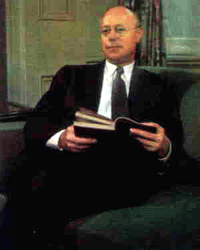Stanley K. Schultz
Professor Emeritus of History
University of Wisconsin-Madison
 |
||||||||
|
|
|
||||||
The conservative answer from Congress was a major piece of legislation still on the books, still enforced from time to time, a piece of legislation in 1947 called the Taft-Hartley Act. That act was the attempt of conservatives to destroy big labor in America, or if not to destroy it, to hedge in and to limit the expression of its power. Conservatives Enact Taft-Hartley
The Taft-Hartley Act had a number of clauses to it, but there were
several that I think are particularly important for you to know about. As matters turned out, Taft-Hartley may have strengthened American labor in the long-run rather than weakened it, because workers and union leaders tended to band together in the face of Taft-Hartley. The American Federation of Labor (AFL) formed back in the 1880s, and the Congress of Industrial Organizations (CIO), which arose in the late 1930s had been in competition with one another for national prominence and membership. They now saw a common threat and began to have talks to join together. In 1955 the two largest unions, the AFL and the CIO, united to become one giant union, AFL-CIO, with some 16 million new members [note that the audio lecture incorrectly states the year as 1945].
The economy faced major obstacles in this crucial decade following the end of World War II. Truman, with no success, had sought to continue a number of the New Deal economic programs, as well as introducing even more liberal economic reforms in his Fair Deal proposals. Conservative congressional opposition had batted down those proposals and limited government controls over economic affairs. Results in the economy pretty much mirrored results in politics in general. There had been a definite political shift to the right; there had been a definite economic shift to the right. If we were to summarize politically and economically the Fair Deal proposals of Harry Truman, we would have to conclude that liberalism certainly was on its way out in America. If we look at what I label
the psychological shift to the right that occurred in the late 1940s
and early 1950s, our conclusion becomes stronger. That psychological
shift we could fairly call the "Second Red Scare." Remember
the first Red Scare back in the 1920s. Well, there was also a fear of
radicalism, anarchy, communism—particularly the communism of the
Soviet Union—that filled American society in the late 1940s and
into the early 1950s. That Second Red Scare is known more popularly
by one word, "McCarthyism," after the junior Republican
Senator from scenic Appleton, Wisconsin, Joseph McCarthy [voice
of Joe McCarthy]. |
||||||||
| Conclusion: That psychological shift to the right was part and parcel of a new set of foreign policies, a new set of domestic policies, a new set of psychological and emotional responses in the United States—collectively all are known together as the Cold War. That Cold War, which had its origins in World War II, dominated America, not only in the late 40s and the early 50s, but down to the present. The story of the Second Red Scare ("McCarthyism"), as well as the story of the origins and growth of the Cold War mentality in the United States is one of the most important things that we will have an opportunity to talk about. It's extraordinarily important-how important?-why, so important, in fact, we'll take up next time The Coils of Cold War. |
||||||||


